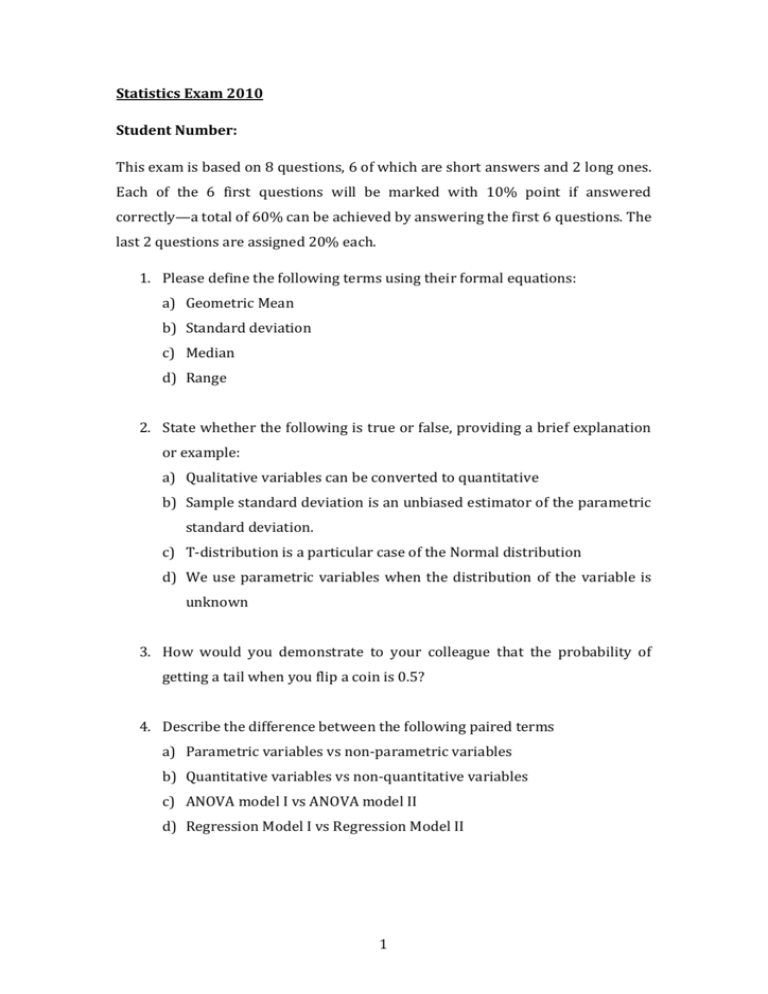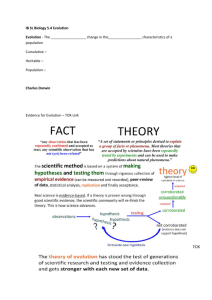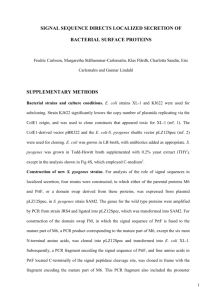Statistics Exam 2010 Student Number: This exam is based on 8
advertisement

Statistics Exam 2010 Student Number: This exam is based on 8 questions, 6 of which are short answers and 2 long ones. Each of the 6 first questions will be marked with 10% point if answered correctly—a total of 60% can be achieved by answering the first 6 questions. The last 2 questions are assigned 20% each. 1. Please define the following terms using their formal equations: a) Geometric Mean b) Standard deviation c) Median d) Range 2. State whether the following is true or false, providing a brief explanation or example: a) Qualitative variables can be converted to quantitative b) Sample standard deviation is an unbiased estimator of the parametric standard deviation. c) T-distribution is a particular case of the Normal distribution d) We use parametric variables when the distribution of the variable is unknown 3. How would you demonstrate to your colleague that the probability of getting a tail when you flip a coin is 0.5? 4. Describe the difference between the following paired terms a) Parametric variables vs non-parametric variables b) Quantitative variables vs non-quantitative variables c) ANOVA model I vs ANOVA model II d) Regression Model I vs Regression Model II 1 5. Please conduct the following calculations in the table below: i10 a) Y i i1 b) Y 10 c) y i i1 d) Variable Data Y 2.5 6 8.1 9 3.5 4.2 4.2 3.6 7 10 6. What is the main idea behind using ANOVA? 7. After waking up one morning of December, Carlos noticed certain uneasiness because he has been feeling tired continuously for the last few months. His worry was enhanced by a report in TV in which being tired was related to cancer. In that report he heard many numbers and percentages: tests for cancer have a high success rate of 99%, in a population of 100,000 people--as the one Carlos belong to--1 in 10 people die of cancer, cancer is genetically linked in as much as 25%, etc. His worry increased when he realised that his dad actually died of cancer. Next day, Carlos took a blood test and a cancer test, the second of which tested positive. The doctor told Carlos that he has one year of life left as he tested positive and he should get his things sorted out before the day comes. Carlos worries and started planning how would he spend the money he has been saving for a long time before next year. Days later, however, Carlos seemed a bit happier—totally convinced everything was fine. His friend Mario, who knew about the sad news, could not understand his emotional state, particularly when Carlos made a mysterious statement: “Everything is about probabilities, Mario”. Why do you think Carlos made such a statement? 2 8. An Evolutionary Biologist was trying to compare the evolution of two groups of bacteria, the gamma-proteobacteria and the alpha proteobacteria. To do so, he needed to compare the evolutionary rates of several proteins isolated and sequenced from several bacteria of these groups. The main steps the scientists needed to make were: a) Sequence different number of proteins in the two groups of bacteria, each group containing several strains of bacteria. b) Measure the evolutionary distances within each group of bacteria for each protein c) Compare the evolutionary distances for each protein between the two groups of bacteria Due to the limited resources the scientist had, he could not sequence the same proteins in the two groups of bacteria. The sequences, however, for different proteins were available in the databases for both groups of bacteria. He decided to take different proteins for both groups and measure their evolutionary rates within the bacteria groups. The rates of evolution for each group and protein were as follows: Gamma proteobacteria: Number of bacteria = 5 Number of proteins = 5 Protein A 0.25 0.20 0.15 0.30 0.20 0.34 0.23 0.22 0.34 Protein B 0.10 0.15 0.30 0.36 0.41 0.40 0.40 0.30 0.41 Protein C 0.23 0.21 0.20 0.34 0.31 0.29 0.20 0.21 0.22 3 Protein D 0.34 0.32 0.32 0.33 0.30 0.31 0.31 0.30 0.30 Protein E 0.40 0.44 0.39 0.39 0.38 0.39 0.37 0.38 0.38 Alpha proteobacteria: Number of bacteria = 5 Number of proteins = 3 Protein F 0.52 0.44 0.46 0.40 0.34 0.44 0.48 0.46 0.35 Protein G 0.36 0.36 0.39 0.30 0.30 0.36 0.37 0.40 0.33 Protein H 0.41 0.41 0.49 0.45 0.45 0.46 0.45 0.43 0.43 a) What are the main statistical steps to be followed in order to compare both populations of proteins? b) Perform a statistical approach to test whether both groups of bacteria are evolving at different rates. 4










